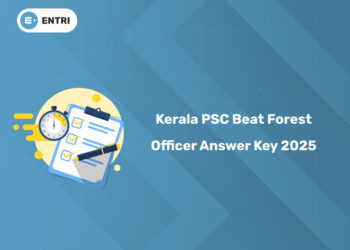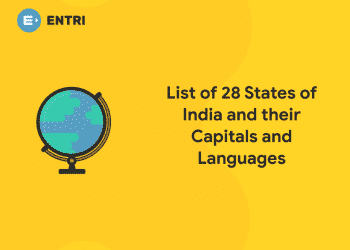Table of Contents
The Kerala PSC has announced the exam date for the Finger Print Searcher (Category No. 233/2024) post. The exam will be conducted on December 18, 2025, and the official syllabus has been released. Candidates who have confirmed their participation are advised to begin systematic preparation without delay. In this blog, we provide the detailed syllabus and exam pattern to help you plan your strategy.
Kerala PSC Finger Print Searcher (233/2024) Exam 2025 Highlights
| Kerala PSC Finger Print Searcher Exam: Overview | |
| Name of Organization | Kerala Public Service Commission (KPSC) |
| Category Number | 233/2024 |
| Name of the Post | Finger Print Searcher |
| Recruited For | Police (Finger Print Bureau) |
| No of Vacancies | Anticipated |
| Admit Card Release | December 04, 2025 |
| Date of Examination | December 18, 2025 |
| Type of Exam | OMR |
| No of Questions | 100 |
| Total Marks | 100 |
| Exam Duration | 1 Hour 15 Minutes |
| Mode of Recruitment | Direct |
| Official Website | thulasi.psc.kerala.gov.in |
Kerala PSC Finger Print Searcher Previous Question Paper PDF
1: The first recipient of the ‘Rajiv Gandhi Khel Ratna’ award?
| Category Number | Download PDF |
| 139/2020 |
Enroll in Kerala's Top-rated HSA Coaching Program!
സർക്കാർ ജോലി എന്ന സ്വപ്നം ഇനി സ്വപ്നം മാത്രമല്ല! Join Entri's HSA Coaching Program
Join Now!Download Kerala PSC Finger Print Searcher Syllabus 2025 PDF
For candidates preparing for the Kerala PSC Finger Print Searcher exam, the official syllabus PDF is a valuable resource. It outlines all topics and subtopics for effective preparation. Download the Kerala PSC Finger Print Searcher Syllabus 2025 PDF from the official website or via the link below.
Make sure to refer to the PDF frequently as you prepare, and use it to track your progress and focus on key areas.
Kerala PSC Finger Print Searcher Exam Pattern 2025
Check out the Kerala PSC Finger Print Searcher Exam Pattern 2025 below. This table shows the module-wise marks distribution.
- Total marks: 100
- Medium of Question: English
- Exam Duration: 1 Hour 30 Minitues
- Negative Marks: 1/3
| Module | Topics Covered | Marks |
|---|---|---|
| Module I | Mechanics & Waves: Particle dynamics, Newton’s laws, SHM, wave motion, elasticity, viscosity, Doppler effect, frames of reference, Special Relativity | 12 |
| Module II | Electricity & Semiconductor Physics: Electrostatics, current electricity, transient currents, electromagnetic induction, AC, magnetic properties, diodes, transistors, amplifiers, oscillators, logic gates | 12 |
| Module III | Optics & Thermodynamics: Reflection, refraction, interference, diffraction, polarization, fibre optics, lasers, spectroscopy, heat transfer, thermodynamics, statistical distributions | 12 |
| Module IV | Atomic & Nuclear Physics, Crystallography: Bohr model, vector atom model, hydrogen spectra, nuclear structure, radioactivity, fission & fusion, crystal structure, Bragg’s law, superconductivity, Schrödinger equation | 14 |
| Module V | Quantum Mechanics & Chemical Applications: Schrödinger equation, hydrogen atom, molecular energy levels, spectroscopy, solids & defects, solutions, volumetric analysis, chromatography, pollution, silicones, cement, fertilizers, rocket propellants | 12 |
| Module VI | Atomic Structure & Inorganic Chemistry: Quantum theory, orbitals, electronic configuration, bonding (ionic, covalent, metallic, hydrogen), periodic properties, metals, coordination compounds, organometallics, radioactivity | 14 |
| Module VII | Thermodynamics, Chemical Kinetics & Physical Chemistry: Kinetic theory, laws of thermodynamics, entropy, chemical equilibrium, reaction kinetics, photochemistry, adsorption, colloids, phase equilibria, electrochemistry | 12 |
| Module VIII | Organic Chemistry & Biomolecules: Carbon compounds, stereochemistry, optical activity, electronic effects, reaction mechanisms (SN1, SN2, E1, E2), hydrocarbons, functional groups, aromaticity, Grignard reagent, polymers, carbohydrates, proteins, nucleic acids, vitamins | 12 |
Prepare for Finger Print Searcher KPSC Exam!
Kerala PSC Finger Print Searcher Detailed Syllabus 2025 Here!
Get the Kerala PSC Finger Print Searcher Detailed Syllabus 2025 here! This comprehensive guide covers all topics and subtopics to help you prepare effectively for the exam.
Module I – Mechanics & Waves (12 Marks)
- Particle dynamics: Newton’s laws of motion, rotational dynamics
- Conservation laws: Linear momentum, angular momentum, energy
- Simple harmonic motion, damped and forced oscillations
- Wave motion: Progressive waves, superposition of waves, Doppler effect
- Frames of reference, Special Theory of Relativity
- Elasticity: Young’s modulus, rigidity modulus, bulk modulus
- Surface tension, viscosity
Module II – Electricity & Semiconductor Physics (12 Marks)
- Electrostatics, transient current, current electricity
- Electromagnetic induction, alternating current
- Magnetic properties of materials
- Semiconductor physics: Diodes, transistors, amplifiers, oscillators, logic gates
Module III – Optics, Heat & Thermodynamics (12 Marks)
- Reflection, refraction, dispersion, interference, diffraction, scattering, polarization
- Fibre optics, lasers, basic spectroscopy
- Heat and thermodynamics: Conduction, convection, radiation, laws of thermodynamics, Carnot engine, entropy
- Statistical distributions: Ensemble, phase space, Maxwell-Boltzmann statistics
Module IV – Atomic & Nuclear Physics, Crystallography (14 Marks)
- Bohr atomic model, vector atom model, hydrogen spectra
- Nuclear structure and properties, radioactivity, nuclear fission and fusion, elementary particles
- Crystal structure, crystal symmetry, Miller indices, Bravais lattice, Bragg’s law, packing fraction, superconductivity
- Wave nature of matter, uncertainty principle, postulates of wave mechanics, Schrödinger equation
Module V – Quantum Mechanics & Chemical Applications (12 Marks)
- Eigenfunctions and eigenvalues, postulates of quantum mechanics
- Time-independent Schrödinger equation
-
Particle in a one-dimensional box
-
Normalization of wave functions
-
Application to hydrogen atom (radial and angular functions – mention only)
-
Orbitals and quantum numbers
-
- Energy levels in molecules – Born-Oppenheimer approximation
- Spectroscopy: Rotational, vibrational, Raman, electronic, and NMR spectroscopy – basic principles and applications
- Elements of molecular symmetry
- Solids: Amorphous and crystalline solids, defects in crystals (stoichiometric and non-stoichiometric)
- Solutions: Ideal and non-ideal solutions, Henry’s law, Raoult’s law, colligative properties, abnormal molecular mass, Van’t Hoff factor
- Solubility product, common ion effect, precipitation of cations
- Volumetric analysis: Principles, theories of indicators
- Chromatography: Column, paper, thin-layer, ion-exchange – Rf values
- Structure and applications of silicones, silicates, zeolites
- Cement, glass, inorganic fertilizers, rocket propellants (brief study)
- Types of pollution: Air and water, pollutants, control methods
Module VI – Atomic Structure & Inorganic Chemistry (14 Marks)
- Atom models: Planck’s quantum theory, photoelectric effect, de Broglie relation, dual nature of matter and radiation
- Heisenberg uncertainty principle, atomic orbitals, quantum numbers
- Pauli exclusion principle, Hund’s rule, Aufbau principle, electronic configuration of atoms
- Ionic bond: Properties, Born-Landé equation (derivation not expected), Born-Haber cycle, Fajan’s rules and applications
- Covalent bond: Valence bond theory, VSEPR theory, hybridization (sp, sp², sp³, dsp², sp³d, d²sp³, sp³d²)
- Molecular orbital theory (LCAO), bonding & antibonding orbitals, bond order
- Metallic bonding: Free electron theory, valence bond theory, band theory (basic concepts)
- Hydrogen bonding – intra- and intermolecular
- Periodic laws, periodic properties, electronegativity scales (Pauling & Mulliken), effective nuclear charge, Slater rules, diagonal relationship
- Representative & transition elements: General characteristics, preparation, properties of simple compounds
- Lanthanides and actinides
- Metals: Occurrence, concentration of ores, refining, extractive metallurgy of Al, Fe, Ni, Cu, Ti, classification and hardening of steel
- Coordination compounds: Isomerism, Werner’s theory, EAN rule, valence bond theory, crystal field theory, splitting of d-orbitals in octahedral, tetrahedral, square planar complexes, applications
- Organometallic compounds: Definition, classification, applications
- Radioactivity: Natural & artificial, nuclear stability (N/P ratio), nuclear forces, half-life, Geiger-Nuttall rule, disintegration series, transmutation, nuclear fission & fusion, applications of radioactive isotopes
Module VII – Thermodynamics, Chemical Kinetics & Physical Chemistry (12 Marks)
- Postulates of kinetic theory of gases, collision number
- First law of thermodynamics, Joule-Thomson effect, liquefaction of gases, inversion temperature
- Second law of thermodynamics, concept of entropy, entropy as criterion of spontaneity
- Free energy functions, Hess’s law, bond energies
- Third law of thermodynamics
- Chemical equilibrium: Law of mass action, equilibrium constants (concentration, partial pressure, mole fractions), Van’t Hoff equation, Le Chatelier’s principle and applications
- Reaction kinetics: Factors affecting rate, rate law, order and molecularity, rate constants (zero, first, second, third order), half-life for first-order reaction, Arrhenius equation, collision theory, transition state theory, homogeneous and heterogeneous catalysis, enzyme catalysis
- Photochemistry: Photosynthesis, simple photochemical reactions, fluorescence, phosphorescence
- Adsorption: Chemisorption & physisorption, factors affecting adsorption, adsorption isotherms
- Colloids: Classification, preparation, purification, properties, protective colloids, gold number, applications
- Phase equilibria: Components and degrees of freedom, one- and two-component systems (simple cases)
- Electrochemistry: Faraday’s laws, Kohlrausch’s law, Arrhenius theory, Ostwald’s dilution law, Debye-Hückel-Onsager equations for strong electrolytes, galvanic cells, electrochemical series, Nernst equation
Module VIII – Organic Chemistry & Biomolecules (12 Marks)
- Uniqueness of Carbon: Classification of organic compounds, hybridization of carbon in organic compounds
- Structural and Stereoisomerism: Baeyer strain theory, conformations, configurations
- Optical Activity: Specific rotation, chirality, enantiomers, diastereomers, racemic mixture, resolution methods
- Electronic Effects: Inductive effect, mesomeric effect, hyperconjugation, electromeric effect, steric effect
- Organic Reactions: Substitution, addition, elimination, rearrangement reactions
-
Mechanisms: SN1, SN2, E1, E2
-
-
Nomenclature & Properties:
-
Preparation and properties of alkanes, alkenes, alkynes, alkyl halides, alcohols, aldehydes, ketones, carboxylic acids, and their derivatives
-
- Aromaticity: Huckel’s rule, structure and stability of benzene, electrophilic substitution reactions with mechanisms
- Grignard Reagent: Preparation and synthetic applications
- Polymers: Classification, preparation and applications of important polymers, biodegradable polymers
- Biomolecules: Carbohydrates, proteins, nucleic acids, vitamins – classifications, examples, applications/functions
Enroll in Kerala's Top-rated HSA Coaching Program!
സർക്കാർ ജോലി എന്ന സ്വപ്നം ഇനി സ്വപ്നം മാത്രമല്ല! Join Entri's HSA Coaching Program
Join Now!How to Download the Kerala PSC Finger Print Searcher Syllabus 2025
Follow these steps to access the syllabus PDF:
- Visit the Official Website: Go to the Kerala Public Service Commission’s official website keralapsc.gov.in.
- Navigate to the Syllabus Section: Look for the “Syllabus” under the “Downloads” section on the homepage.
- Find the Finger Print Searcher Exam Syllabus: Locate the syllabus for the Finger Print Searcher post (233/2024).
- Download the PDF: Click on the link for the Finger Print Searcher syllabus to view it. There should be an option to download the PDF. Click on the download icon or link to save the file to your device.
Preparation Tips for Kerala PSC Finger Print Searcher Exam 2025
- Understand the Syllabus: Break down the syllabus into manageable sections and create a study plan.
- Use Quality Resources: Refer to standard textbooks and study materials that cover the entire syllabus.
- Practice Previous Papers: Solving past exam papers and sample questions can help familiarize you with the exam format and question types.
- Time Management: Allocate specific times for each subject in your study schedule to ensure comprehensive preparation.
- Join Study Groups: Engaging in study groups can be highly beneficial. Joining with peers and participating in discussions on Entri can provide valuable insights, practice questions, and motivational support for your finger print searcher preparation.











